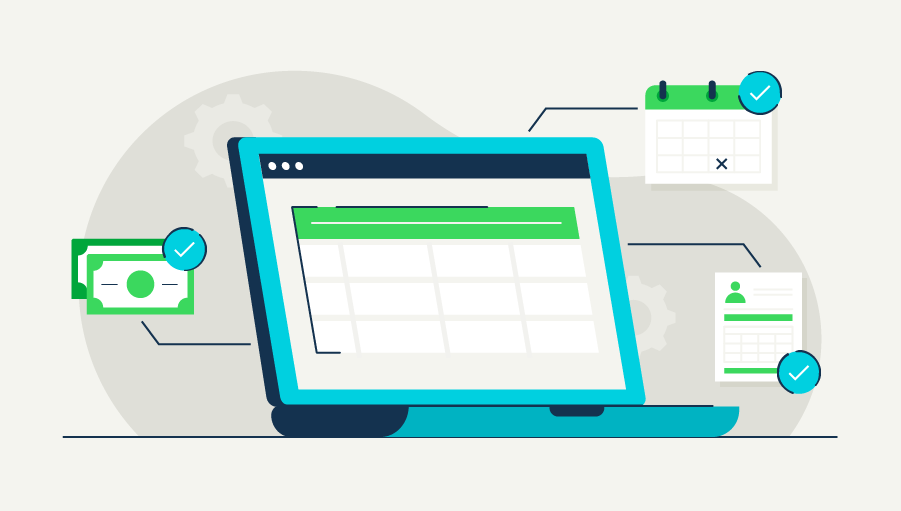If you’re a small business owner, chances are good you’re the one handling payroll. Figuring out how to process payroll can be intimidating, but don’t worry. Processing payroll is easier than you think. This guide will take you through the payroll process step by step, so you’re confident and ready for payday.
Payroll processing is the act of managing employee payments. It covers everything from entering an employee into your payroll software to giving them their paychecks. The basic payroll processing steps involve collecting employee information, and setting up a schedule, and issuing payments, all while keeping accurate records.
For processing employee payroll, there are nine basic steps from start to finish:
3. Gather employee information
5. Establish a time-tracking system
6. Collect employee timesheets
What is payroll processing?
Payroll processing is the act of managing employee payments. It covers everything from entering an employee into your payroll software to giving them their paychecks. The basic payroll processing steps involve collecting employee information, setting up a schedule, and issuing payments, all while keeping accurate records.
How long does it take? It depends on a few factors, like your business’s size, payroll complexity, and whether you do it manually or via payroll software.
Take a look at these time estimates to get an idea of how long payroll processing might take:
As you can see, using an automated payroll software solution like QuickBooks can greatly reduce processing time compared to manual methods. Based on an Intuit survey of 2,040 QuickBooks Online Payroll customers in February 2023, respondents save an average of 2.56 hours per pay period and 3.93 hours per week.
Why is payroll processing important?
You might think payroll processing is only about paying your employees, but there’s more to it than that. Let’s take a look at some of the key reasons why payroll processing is important for your small business:
1. Ensures employees are paid correctly and on time
Nothing frustrates employees faster than a payroll mistake. Late, missing, or incorrect paychecks can create serious stress, lower morale, and even push employees to look for new opportunities. In fact, according to HRO Today, nearly 50% of workers would start looking for a new job after just two payroll errors. A well-run payroll system helps you avoid those headaches.
2. Keeps your business compliant
Your business is required to deduct federal, state, and local payroll taxes, including Social Security, Medicare, and unemployment taxes. There are also labor laws, like the Fair Labor Standards Act (FLSA), which set the rules for minimum wage, overtime pay, and recordkeeping. If something’s off—like missing a tax payment or miscalculating wages—you could end up facing penalties from the IRS, state fines, or even legal trouble from employees.
3. Helps with financial management
Payroll is one of the biggest expenses for most businesses, so tracking it accurately is key to budgeting and cash flow management. When you have a clear picture of wages, taxes, and benefits, it’s easier to plan ahead and keep your finances in check.
Plus, businesses that track payroll costs effectively can actually save money. According to the same Intuit survey mentioned above, companies that actively manage gross payroll costs save an average of 4.64%. That’s money that can be reinvested back into your business.
4. Reduces administrative burden
As mentioned earlier, opting for an automated payroll system like QuickBooks can save time and reduce the hassle of managing payroll manually. Instead of spending hours calculating wages, taxes, and deductions by hand, payroll software automates the entire process, from tracking employee hours to processing payments and filing taxes. Ultimately, this gives you more time to focus on strategy, operations, and taking care of your team.
Stages of payroll processing
When looking at the big picture, payroll processing can be broken down into three stages: data collection, calculation, and disbursement.
1. Data collection
In the data collection stage, you need to gather all the necessary information to run payroll. This includes defining internal payroll policies—such as pay frequency, overtime rules, and benefits eligibility—and collecting up-to-date employee data like Social Security numbers, tax withholding forms (e.g., W-4s), direct deposit details, and job classifications.
You’ll also need to track hours worked, vacation time, sick days, and any commissions or bonuses. For example, if you use a time-tracking app like QuickBooks Time, this data can be pulled straight into your payroll system to save you time and reduce errors.
2. Calculation
Once you’ve got all the data, it’s time for the calculation stage. You’ll calculate each employee’s gross pay based on hours worked or salary agreements. Then, they apply mandatory deductions such as federal and state income taxes, Social Security and Medicare (FICA), and any applicable local taxes. Voluntary deductions—such as health insurance premiums, retirement plan contributions, or wage garnishments—are also subtracted. The result is each employee’s net pay, or take-home amount. For example, if an employee earns $2,000 in gross pay but has $500 in combined deductions, their net pay would be $1,500.
3. Disbursement
Finally, in the disbursement stage, you pay your employees and take care of your payroll tax responsibilities. You’ll send payments through direct deposit, paper checks, or pay cards—whatever works best for your team and your company’s setup. Beyond just getting paychecks out, you also need to file payroll taxes with the IRS and your state, submit reports like the quarterly 941 form, and issue year-end tax forms such as W-2s or 1099s.
Don’t forget to reconcile your payroll records and keep everything well-documented. That way, you're ready for audits and can catch any errors early. If you’re using a payroll service or software like QuickBooks Payroll, you can automate most of this and save yourself a lot of time.
Cycles of payroll processing
Each payroll cycle has its own advantages and challenges, and your business should choose the one that best suits your financial operations, industry standards, and workforce preferences. Here are the most common payroll cycles:
How to process payroll in 9 steps
Running payroll may seem like a big task, but when you break it down step by step, it becomes much more manageable. Follow the nine steps below to help keep your business organized and compliant.
1. Choose a payroll system
How does payroll work? Processing payroll isn’t just about compensating your employees. It’s part of operating your business legally—according to state laws and the Fair Labor Standards Act (FLSA).
The FLSA has several requirements that fit into your payroll process, from tracking employee time at work to recordkeeping. You’ll want to remember those regulations when figuring out how to process payroll.
There are three basic payroll systems:
- Manual payroll means you’re doing payroll by hand, typically on paper or in a spreadsheet. While there are no upfront costs, you’re trading that off for your time and effort, which could be spent on growing your business. Plus, there’s an increased risk of human error that could lead to everything from underpaying employees to facing IRS penalties. If you only have a few employees, this method may suffice, but as your business scales, it’s best to transition to one of the next two options.
- Outsourced payroll means you hire a payroll provider, accountant, or bookkeeper to handle payroll on your behalf. The biggest advantage is peace of mind, knowing that a professional handles everything from calculating wages to ensuring compliance. The downside is that outsourcing is usually more expensive than manual payroll or payroll software. If your business doesn’t have the time or expertise to manage payroll in-house, outsourcing can be a great option, especially if you have complex pay structures or multi-state employees.
- Payroll software varies by plan or product. Most providers offer everything from basic payroll assistance to additional payroll services that may include time tracking or even human resource services. For small to medium-sized businesses, payroll software is often the best balance between cost, efficiency, and control. It streamlines payroll without the time-consuming burden of manual calculations or the higher costs of outsourcing.
Before you commit to one system over another, consider factors like business growth, employee benefits, and the complexity of your state’s payroll taxes and laws.
2. Create a payroll policy
After deciding on the type of payroll, whether in-house or outsourced, it’s time to set up a payroll policy. First, you’ll want to review your local labor laws, state overtime laws, and federal labor laws. A common FLSA violation to watch out for is unpaid overtime, which can happen unintentionally when you don’t know the rules.
Here are other things to include in your payroll policy:
Pay dates, including the length of each pay period and when you pay employees after that.
Payment methods, such as how you’ll pay employees—usually by direct deposit or paper check.
Payroll deductions and withholdings, including your procedures for paying the appropriate payroll taxes.
Payroll benefits and how they will impact the employee’s paycheck.
Once this is in place, you’re ready to start collecting employee information.
3. Gather employee information
Now it’s time to get the necessary information from your employees to ensure you’re paying them the correct amount, as well as making the necessary withholdings and deductions. That means collecting certain forms like Form W-4.
Such documents will provide each employee’s personal information, Social Security number, and tax filing status. If your payroll includes employee health insurance or retirement savings, you’ll need documentation showing the employee has approved additional deductions.
Lastly, if you plan to offer direct deposit, now is the time to get employee consent and collect their banking information.
Below is a list of essential forms and details that you should gather during the onboarding process:
4. Set up direct deposit
As a business owner, you can set up direct deposit directly through your business’s bank account or payroll service provider. Direct deposit is convenient for both you and your employees. If your employees have opted for direct deposit, they’ll have to give you some information:
- Bank name
- Account type (checking or savings)
- Account number
- Bank routing number
Once you have this information, the next step is to transfer it to your payroll software or bank.
5. Establish a time-tracking system
With a payroll policy, employee info, and a direct deposit in place, it’s time to track hours. The FLSA requires employers to maintain accurate records of work hours for all non-exempt employees. In most cases, non-exempt (as opposed to exempt) includes hourly employees.
One way to maintain those records is to track hours manually and ask employees to write down when they clock in and out. Otherwise, you might try a time-tracking software that holds onto employee timesheet records for you. Either way, you’ll want to train employees to track their time as soon as possible.
6. Collect employee timesheets
Depending on the payroll processor, those timesheets may already be sitting inside your payroll software, waiting for approval. If not, now is the time to import them into your payroll software. If you have paper time cards, you’ll need to add up the hours, check for any mistakes, and transcribe the numbers to your payroll records.
7. Approve and submit payroll
Once you approve all your employee time cards, you’re ready to run payroll and issue payments. Approval is one of the most important steps when running payroll for employees. This is your chance to make sure all the hours add up correctly so payroll is accurate.
8. Report and update payroll records
Now that the payroll payments are on their way to your employees, it’s time to update your payroll records. Those records must show you withheld all necessary taxes and deductions.
Payroll records are important for other reasons, too. For instance, the Age Discrimination in Employment Act (ADEA) requires employers to keep all payroll records for three years. That information must include any employee benefit plans (including retirement or insurance) and any written seniority or merit system.
Here’s a breakdown of the key post-payroll tasks and why they matter:
1. Issue pay stubs
Pay stubs give your employees a clear breakdown of their pay, including gross wages, tax withholdings, deductions, and net pay. Even if your state doesn’t legally require pay stubs, it’s still a best practice to provide them. They help employees understand their earnings and can reduce the number of payroll questions you receive. Many payroll systems automatically generate digital pay stubs, making this step quick and easy.
2. Submit withheld payroll taxes
Once you’ve withheld federal, state, and local taxes from your employees’ paychecks, you need to send that money to the appropriate agencies on time. This includes Social Security and Medicare taxes (FICA), federal unemployment tax (FUTA), and state unemployment tax (SUTA). Missing a deadline can result in costly penalties and interest, so make sure you’re clear on your deposit schedule—some businesses pay monthly, others semi-weekly.
3. File payroll tax forms
Along with paying payroll taxes, you also need to file the right forms to report what you’ve paid. That includes Form 941 (quarterly federal tax return), Form 940 (annual FUTA tax return), W-2s for employees, and 1099-NECs for independent contractors. These forms help federal and state agencies track tax compliance and provide documentation for your employees at tax time. Filing electronically through a payroll service or IRS e-file system can make the process smoother.
4. Update payroll records
After each payroll run, you should update your records to reflect all payments, deductions, and adjustments. Keeping things organized now will save you time and stress when it comes to quarterly or year-end filings. It also helps you quickly resolve any issues if an employee spots an error on their pay stub or has a question about past wages.
5. Keep records for compliance
Several laws require you to keep payroll records for a minimum amount of time. The ADEA and Fair Labor Standards Act (FLSA) require records to be kept for at least three years, while the IRS recommends holding onto employment tax records for four years. These documents include timecards, tax forms, pay stubs, benefit plans, and any communication regarding compensation. Having thorough records on hand makes audits, employee disputes, and tax prep much easier to handle.
6. Reconcile payroll transactions
Finally, take a few minutes to reconcile your payroll. That means comparing your payroll reports against your bank statements, general ledger, and tax filings to make sure everything adds up. This step helps catch any errors—like duplicate payments or incorrect tax amounts—before they snowball into bigger problems. It’s a good habit to get into at the end of every payroll cycle, especially if you’re managing things manually or across multiple platforms.
9. Report any new hires
If you have any new hires, you’re required to report them to your state’s new hire reporting agency, per the Personal Responsibility and Work Opportunity Reconciliation Act (PRWORA) of 1996. This process helps the government track employment for things like child support enforcement and prevent fraud claims for unemployment benefits and public assistance.
Each state has its own requirements, but in general, you’ll need to provide:
- Employee details: Full name, Social Security number (SSN), address, and hire date
- Employer details: Business name, Federal Employer Identification Number (FEIN), and company address
Most states allow you to submit new hire info online, by mail, or fax through the state’s new hire reporting system. Federal law requires you to report new hires within 20 days, but some states have shorter deadlines, so check your state’s requirements.
Tips to improve payroll processing
There are ways to ensure your payroll runs as smoothly as possible. Here are some tips and tricks to help get you through your payroll cycle:
Calculate your total payroll costs
Keep track of all expenses related to payroll, including wages, overtime hours, bonuses, and benefits. An accurate overview of the total payroll costs will help with budgeting and financial planning.
Make payments and reports on time
You’ll want to adhere to all payment and reporting deadlines established by federal, state, and local authorities. Timely submission of payroll taxes, tax withholdings, and other required reports will prevent penalties and unnecessary audits.
Keep excellent records
Maintain detailed and organized payroll records as you process payroll, including employee information, wage rates, tax withholdings, and benefit plan details. This ensures compliance with recordkeeping requirements and provides documentation in case of audits or disputes.
Remain up-to-date with payroll laws
Regularly review and ensure you’re in compliance with minimum wage and other relevant payroll laws. This helps avoid legal issues and maintains fair compensation for employees.
Use payroll software
Implement payroll software like QuickBooks that automates payroll and paycheck calculations, tracks employee hours, and simplifies how you process payroll. This reduces the chances of errors and streamlines the overall payroll workflow.
Use a payroll processing checklist
A payroll processing checklist is a tool that helps ensure accurate and compliant payroll. It includes various components such as classifying workers correctly, collecting and tallying hours, verifying payment information, processing payroll on time, and depositing and reporting employment taxes correctly.
Payroll laws and regulations
While we’ve gone over some payroll laws and regulations throughout this blog, it’s important to reiterate this information to help your business avoid penalties, audits, and potential legal issues.
Here are the key laws and regulations you need to know:
Fair Labor Standards Act (FLSA)
FSLA sets rules for fair pay, including a federal minimum wage of $7.25 per hour and overtime pay at 1.5x for hours over 40 per week. Employers must also keep accurate records of hours and wages.
Federal Insurance Contributions Act (FICA)
FICA requires employers and employees to contribute to Social Security and Medicare. Each pays 6.2% for Social Security and 1.45% for Medicare, adding up to 15.3%.
Federal Unemployment Tax Act (FUTA)
Employers must pay unemployment taxes to help fund benefits for jobless workers. The base tax is 6% on the first $7,000 paid per employee, but businesses paying state unemployment tax can lower this rate to 0.6%.
Recordkeeping requirements
Employers must keep payroll records for at least three years, including work hours, pay rates, and tax deductions, to stay compliant with federal regulations.
Overtime regulations
Non-exempt employees must be paid overtime at 1.5x their normal pay rate when working more than 40 hours in a week. Employers must correctly classify employees to avoid penalties.
Equal pay and anti-discrimination laws
Laws such as the Equal Pay Act and Title VII of the Civil Rights Act prohibit wage discrimination based on gender, race, or other protected statuses.
Classifying workers
Getting worker classification right is one of the most important parts of payroll compliance. Misclassifying employees as independent contractors—or vice versa—can lead to serious consequences, like back taxes, penalties, and even lawsuits. So how do you know the difference?
- Employees (W-2 workers): If someone is an employee, you’re responsible for withholding payroll taxes, covering Social Security and Medicare (FICA), and paying unemployment taxes (FUTA/SUTA). Employees are also entitled to benefits, overtime pay, and legal protections under federal and state labor laws.
- Independent contractors (1099 workers): If you hire an independent contractor, you don’t withhold taxes. They’re responsible for paying their own self-employment taxes. Contractors typically set their own schedules, use their own tools, and don’t receive the benefits or job protections that employees do.
If you misclassify a worker, you could face fines, back pay, and tax penalties. Workers may also sue for unpaid wages, benefits, and legal protections they should have received.
If you're unsure, err on the side of caution or consult a payroll expert. Getting classification right from the start will save you time, money, and legal trouble down the road.
How payroll can impact cash flow
How you manage payroll directly affects your cash flow. If you don’t plan payroll correctly, it can lead to cash shortages and financial strain. Here’s how payroll impacts cash flow and what you can do to keep things running smoothly.
1. Match payroll to your revenue cycles
Challenge: If your business brings in revenue inconsistently (e.g., seasonal businesses or companies with fluctuating sales) but payroll stays the same, you might struggle to cover payroll during slow months.
Solution: Try to align your payroll schedule with your revenue flow. If that’s not possible, build a cash reserve specifically for payroll so you’re never caught off guard.
2. Choose the right payroll frequency
Challenge: Paying employees every week means money is leaving your business more often, which can strain your cash flow—especially if your revenue doesn’t come in as frequently.
Solution: Consider a biweekly or semi-monthly payroll schedule instead of weekly to smooth out cash outflows and give your business more breathing room.
3. Stay ahead of payroll taxes
Challenge: Payroll taxes aren’t optional, and missing a payment can lead to penalties and interest charges. If you’re not setting aside tax money as you go, you might come up short when it’s time to pay.
Solution: Open a separate account for payroll taxes and set aside the right percentage from each payroll run. That way, when tax time comes, you’re ready.
4. Keep overtime and bonuses in check
Challenge: Unexpected overtime, bonuses, or commissions can cause payroll costs to spike, throwing off your cash flow projections.
Solution: Monitor employee hours, set clear overtime policies, and forecast payroll expenses in advance so you’re not blindsided by extra costs.
5. Plan for hiring and turnover costs
Challenge: Hiring employees comes with extra costs beyond their salary, like onboarding, training, and payroll setup. On the flip side, high turnover can also be costly due to recruitment efforts and lost productivity.
Solution: Budget for hiring costs ahead of time and focus on employee retention strategies to reduce turnover-related expenses.
Next steps for streamlining your payroll process
Automated payroll and time-tracking tools can reduce the time to process payroll. One reason is that most payroll processing solutions calculate payroll taxes for you, which could take a while if done by hand.
Meanwhile, payroll services like QuickBooks Payroll can streamline the process and help your employees get paid faster with direct deposit.
Related:
- https://quickbooks.intuit.com/r/payroll/payroll-expenses/
- https://quickbooks.intuit.com/r/payroll/automate-payroll/
- https://quickbooks.intuit.com/r/payroll/payroll-reconciliation/
- https://quickbooks.intuit.com/r/payroll/cost-of-payroll/
QuickBooks Online Payroll & Contractor Payments: Money movement services are provided by Intuit Payments Inc., licensed as a Money Transmitter by the New York State Department of Financial Services, subject to eligibility criteria, credit and application approval. For more information about Intuit Payments Inc.’s money transmission licenses, please visit https://www.intuit.com/legal/licenses/payment-licenses/

Marshall Hargrave is a financial writer with over 15 years of expertise spanning the finance and investing fields. He has experience as an editor for Investopedia and has worked with the likes of the Consumer Bankers Association and National Venture Capital Association. Marshall is a former Securities & Exchange Commission-registered investment adviser and holds a Bachelor's degree in finance from Appalachian State University.



